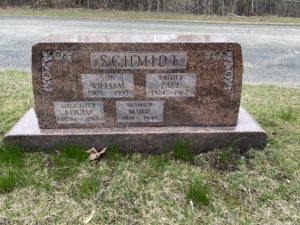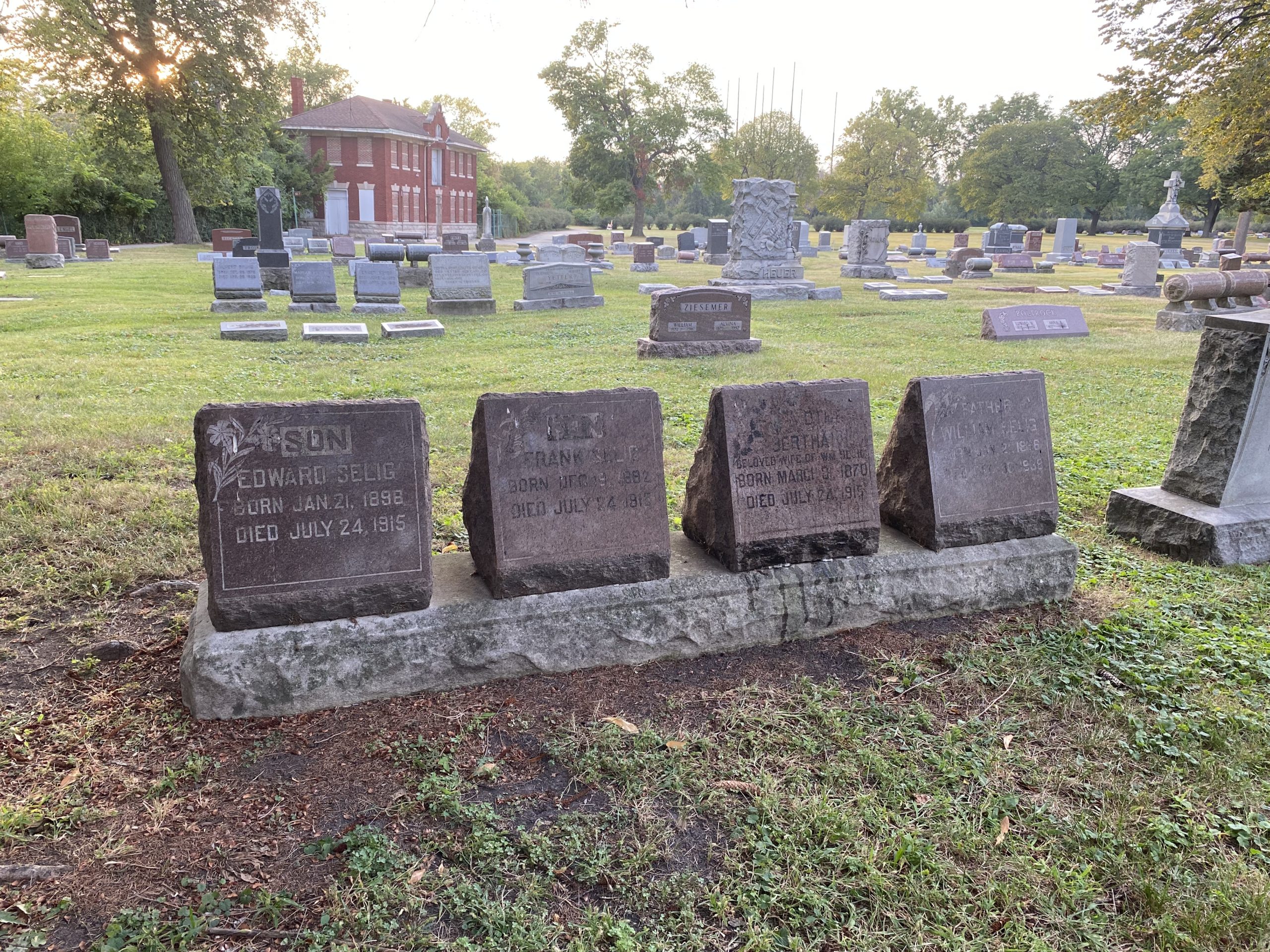Bertha Selig
31 March 1870 — 24 July 1915
Frank Selig
18 December 1892 — 24 July 1915
Edward Selig
21 January 1897 — 24 July 1915
Louise Schmidt
16 May 1896 — 24 July 1915
The Eastland, one of five chartered excursion boats meant to ferry employees, their families and friends from Chicago over to the Michigan City shore for the annual Western Electric Company picnic, keeled over into the Chicago River while still at dock, trapping hundreds inside its hull and leading to the deaths of 844 of the 2,500 passengers aboard at the time of the incident which became known as The Eastland Disaster.
 Edward Selig and Louise Schmidt were both young Western Electric employees who were engaged to be married. They went to the picnic together, along with Edward’s mother and older brother Frank, and all were lost. They are buried separately, the Seligs in their family plot in Section 7, and Louise with her family in Section 8.
Edward Selig and Louise Schmidt were both young Western Electric employees who were engaged to be married. They went to the picnic together, along with Edward’s mother and older brother Frank, and all were lost. They are buried separately, the Seligs in their family plot in Section 7, and Louise with her family in Section 8.
Louise Schmidt was the oldest of six children, the youngest of whom was born three years after her death. Her father Paul immigrated in 1891; her mother Mary in 1893; and they married in 1895. Louise was born the following year.
Paul worked a variety of jobs, eventually landing a stable position at a company in Cicero as a night watchman and fireman. While Louise was alive, it appears he may have worked at Western Electric for a few years though that’s unclear from the census records.
Unlike many families impacted by the disaster, the Schmidts were not dependent on their children for support and the loss of Louise does not appear to have derailed them economically. Her parents both lived to good old ages, her father surviving to 88, sadly outliving three of his children: Louise; Louise’s brother William who died at only 33 of “acute pharyngitis” (which as a diagnosis is just a very bad sore throat where the actual cause of illness — or in this case death — is not diagnosed); and Elsa who married and moved out to South Dakota where she died relatively young at 44.
While these early deaths are very sad, they don’t follow the pattern of the kinds of secondary deaths following soon after Louise’s that I’ve found for many other Eastland families. In those cases, there’s a sense that the trauma impacted the health of the surviving family members, cutting their lives shorter than they may have otherwise been. It is possible that her siblings’ health issues could be tied to the loss of their big sister, but as both died many years afterwards, it’s hard to even speculate as to contributing causes. While I am sure their grief was difficult, there’s evidence that their financial security, overall health at the time of her death, and closeness as a family insulated them from that secondary devastation.
Louisa’s three other siblings all lived into old age with third sister Tillie living to be 97; Edwin, who was only 5 when Louisa died, living to 65; and Mildred, who was born after her oldest sister’s death in 1918, living to 69. A research cul-de-sac note on Mildred is that she was another second wife with the same name as the first which was especially wild in this case as, again, the algorithm mixes up all their information into one Mildred and in this case it was initially quite shocking until I picked the threads apart since Mildred Schmidt was only 13 years old when her eventual husband married his first Mildred. It gets more confusing since the first marriage appears to have ended in divorce which leads to a vast collection of contradictory census and death information all piled together helpfully by both the algorithm and amateur genealogists on ancestry.com. In the end, Louise’s Mildred outlived two husbands.
The Seligs were a similarly more stable family than is often the case with the Eastland victims. William Sr. was an iron molder and steadily worked as such from census to census. Of their seven children, only one (oldest Minna) was lost in infancy which — though disease and accident are no respecters of class — tends to indicate that the family had had a good financial base that allowed them to meet their large family’s basic needs and to afford care when they needed it.
It is unclear if just the three who were lost had gone to the picnic, but at the time of their deaths, Bertha had already seen her two surviving daughters married, Edward was about to be married to Louise, and Bertha’s oldest sons were well employed and independent. Only her youngest child, Henry, was still young enough to need to be at home and even he was fifteen — old enough to go to work in those days. I hope she felt she’d done well in her life and was proud of raising her children into adulthood. She herself at 45 was rather young by modern standards, though she likely didn’t see herself as such based on the standards of her day. The picture posted on her findagrave.com is one of a dignified matron and as she’d already been a grandmother for four years, I’m sure she saw herself through that lens.
Bertha’s husband William remarried just over a year after the loss of his wife and sons (to Ida Sengstock Jungkans who was Florence Begitschke‘s aunt. Ida was also widowed, though not in the disaster). Both are buried with their first spouses.
As I mentioned earlier, in doing histories of the Eastland victims, I often find signs of lingering family trauma while doing my research, and though these two families seem largely to have remained stable and to have weathered their losses without obvious signs or related events, one sign of a possible side-effect of the family’s trauma might be oldest son William Jr.’s leaving what appears to have been an intention to follow in his father’s footsteps and work as an iron molder. He is listed as working in that field in the 1910 census, but after that, his history is very different.
William Jr. never married and by 1920, he’d moved away from Chicago and was living and working as a farmhand in Nebraska. At some point before 1930, he landed with a family called the Hansens in South Dakota where it appears he worked as a farmhand for the rest of his life. When he died, his body was returned to Illinois and he was interred with his parents and brothers.
This is, of course, complete speculation, but here goes: It’s possible the losses were too much for him to bear simply because they happened. As the oldest and oldest brother, he may have felt responsible. If he had been along on the day, the survivor guilt might have been too much for him to stay and live out the life he’d originally intended for himself. His father’s remarriage may also have been the breaking point. Or it’s entirely possible he simply saw this terrible event as a sign to seize the day and do something different, and there’s very little more different from being an ironmonger in Chicago than being a farmhand in South Dakota.
The three other siblings all married, had children, and lived into the 1970s.
RIP Schmidts and Seligs
Please visit my Instagram for any questions or comments on this post!
